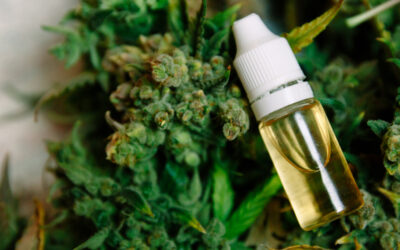CBG is best known for serving as the building block for other, more-recognizable cannabis compounds like THC and CBD, but the non-intoxicating cannabinoid has shown it may have beneficial properties itself.
By now, there is no doubt that you’re well aware of CBD and THC, the cannabis plant’s two most popular cannabinoids, but are you familiar with CBG?
While CBG is a lesser-known cannabinoid not present in large quantities, research findings and anecdotal evidence suggest it has some exciting natural health benefits that make it worth learning about. Some even say CBG oil could be the next big trend in cannabis wellness.
Keep reading to better understand what CBG is, what CBG is good for, what we know about CBG benefits, and more.
What is CBG?
CBG is one of more than 100 cannabinoids native to the cannabis plant. Cannabinoids are a unique class of active chemical compounds that act on receptors in our cells and alter the release of neurotransmitters in the brain.
So what does CBG stand for? CBG is an abbreviation for cannabigerol.
Cannabigerol, or CBG, can be found in small amounts in both hemp and marijuana. It is considered a minor cannabinoid because in most cannabis strains it’s found in low concentrations, usually less than 1 percent in marijuana and less than 2 percent in hemp.1
CBG was first discovered and isolated by Israeli scientists Yehiel Gaoni and Ralph Mechoulam in 1964. Years later, Japanese researchers figured out that CBG starts out as CBGA, or cannabigerolic acid, and over time or when exposed to heat is synthesized into an active cannabinoid.
CBG is a non-intoxicating cannabinoid, meaning that when consumed it won’t cause any type of euphoric effects like THC.4 In fact, some early evidence suggests that CBG may be able to suppress THC’s intoxicating effects.
Where Does CBG Come From?
CBG is the non-acidic form of cannabigerolic acid (CBGA), the foundational compound from which other cannabinoids are synthesized. CBGA is the first cannabinoid to form in cannabis plants. Both hemp and marijuana plants produce cannabigerolic acid (CBGA), the non-acidic form of CBG, in the plant’s trichomes.
Over time, as the plant matures, enzymes break CBGA down into other acidic cannabinoids. A majority of the time, CBGA is synthesized into cannabidiolic acid (CBDA), tetrahydrocannabinolic acid (THCA), and cannabichromenic acid (CBCA). Later, after the cannabis plant is aged or heated through a process called decarboxylation, these acidic cannabinoids convert to their active versions, CBD, THC, and CBC.
It’s rare that CBGA converts to CBG. However, over time and when exposed to heat, CBGA can also be converted to CBG.
Cannabis breeders have started to experiment with genetic manipulation and plant cross-breeding to try and obtain higher yields of CBG. Scientists have also found they can extract higher levels of CBG from budding plants in the form of a CBG oil about six weeks into the eight-week flowering cycle, when CBG levels are highest because it has yet to be converted into other compounds.
What is CBG Good For?
Like other cannabinoids, CBG influences the body and its functions by interacting with the endocannabinoid system within our bodies. The endocannabinoid system, also known simply as the ECS or the EC system, is a complex signaling network responsible for keeping many of the body’s functions in balance.
When you consume cannabis, the body absorbs CBG as well as the other cannabinoids present. CBG and other cannabinoids have a similar chemical makeup to the body’s naturally synthesized endocannabinoids, allowing them to interact with the endocannabinoid system’s cannabinoid receptors.
The endocannabinoid system has two types of cannabinoid receptors, CB1 and CB2. CBG has been found to act as a low-affinity CB1 antagonist, meaning it can dampen the receptor’s associated biological response by partially binding with and blocking it. Studies suggest CBG also binds to CB2 receptors, but its pharmacological activity there is currently unknown.2
CBG has also shown that it may possibly increase levels of Anandamide, one of the body’s natural endocannabinoids that ensures that efficiency of the endocannabinoid system. CBG has been shown to inhibit the enzymes that break down Anandamide, so that more is available to interact with the endocannabinoid system.3
The endocannabinoid system isn’t the only network CBG appears to influence. CBG has also been shown to act as an agonist of 5-HT1A receptors, which manage the release of the neurotransmitter serotonin. With G-protein-coupled α2-adrenergic receptors, CBG acts as an agonist, binding and activating the receptors to potentially influence the release of norepinephrine and epinephrine.2
Studies also indicate that CBG acts on vanilloid receptor 1 (TrpV1), which detects and regulates body sensations and responses to environmental stimuli.3
CBG vs. CBD: How the Two Cannabinoids Compare
The main difference between CBG and CBD is that CBG helps make CBD. While they’re both cannabinoids, they are different compounds within the plant.
When considering CBG vs CBD, it’s also important to point out that they appear to influence the endocannabinoid system in different ways. CBG and CBD both appear to suppress CB1 receptors as indirect agonists, sitting imperfectly inside the receptors so that other chemical messengers cannot bind to them. However, unlike CBG, CBD appears to not directly bind with the endocannabinoid system’s CB2 receptors like CBG does.
Both CBG and CBD are non-intoxicating, meaning their consumption doesn’t cause a user to experience any euphoric effects.
Full-spectrum cannabis oil products contain all of the cannabinoids within the plant, including both CBG and CBD. Compared to consuming isolated CBG, using a product that contains the full spectrum of cannabinoids that are available from hemp could prove to be more beneficial. A theory known as the entourage effect, introduced in 1998 by renowned cannabinoid research in S. Ben-Shabat, describes a potential enhancing effect that takes place when a full spectrum of cannabinoids and other cannabis compounds is consumed through whole plant cannabis oils.
CBG Benefits: What Research Has Found
While cannabis has been used for health purposes for thousands of years, only over the last few decades have scientists begun to identify the plant’s compounds and understand how cannabinoids interact with the body’s natural systems to promote wellness.
Even today, CBG is overshadowed by other more well-known cannabinoids. CBG research is still in its infancy, and we have much more to learn about CBG benefits and how the compound could be used to promote better health.
So what is CBG good for? Findings so far suggest that CBG’s influence on cannabinoid, 5-HT1A, G-protein-coupled α2-adrenergic, and vanilloid receptor systems promote the efficiency and function of the body and its functions, leading to overall better health.
With cannabis research still relatively untapped and more than 100 cannabinoids so far identified, unexplored cannabinoids like CBG will begin to step into the spotlight and be more of a focus point for researchers.
Is CBG Legal?
CBG is legal at the federal level in the United States, provided it comes from hemp. The passage of the 2018 Farm Bill legalized hemp and the plant’s derivatives. The law contained provisions that clarified the legality of all hemp-derived products, including CBG oil.
All marijuana and marijuana-derived compounds remain illegal at the federal level. More than 30 states have passed their own policies permitting the use of marijuana, which would apply to marijuana-derived CBG oil.
While CBG oil is not widely available due to CBG’s low concentrations, CBG is found in legally-accessible full-spectrum hemp-derived oils, such as CBD oil.
Learn More about Cannabinoids
CBG is one of the many compounds in cannabis that have so far been identified.
For more information about cannabinoids and other beneficial compounds found in cannabis, please visit our Cannabis 101 page.
References:
- Cannabigerol (CBG) – Better Than CBD? 420 Evaluations. Retrieved from https://420evaluationsonline.com/health-and-news/cannabigerol-cbg-better-than-cbd.
- Cascio, M.G., Gauson, L.A., Stevenson, L.A., Ross, R.A., and Pertwell, R.G. (2010, January). Evidence that the plant cannabinoid cannabigerol is a highly potent α2-adrenoceptor agonist and moderately potent 5HT1A receptor antagonist. British Journal of Pharmacology, 159(1), 129-41.
- De Petrocellis, L., Ligresti, A., Moriello, A.S., Allarà, M., Bisogno, T., Petrosino, S., Stott, C.G., and Di Marzo, V. (2011). Effects of cannabinoids and cannabinoid-enriched Cannabis extracts on TRP channels and endocannabinoid metabolic enzymes. British Journal of Pharmacology, 163(7), 1479–1494.
- Gaoni, Y., and Mechoulam, R. (1964). Hashish II. The structure and synthesis of cannabigerol, a new hashish constituent. Proceedings of the Chemical Society, 82.






